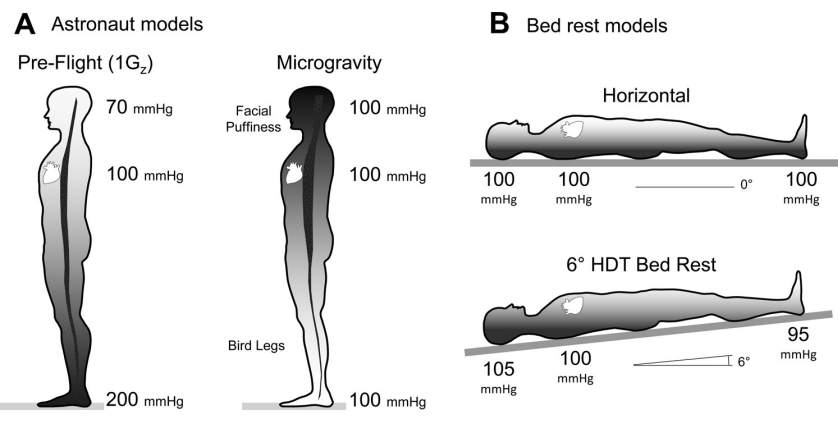Though there are no firm plans for a crewed mission to Mars, we all know one’s coming. Astronauts routinely spend months at a time on the ISS, and we’ve learned a lot about the hazards astronauts face on long missions. However, Mars missions can take years, which presents a whole host of problems, including astronaut nutrition.
Nutrition can help astronauts manage spaceflight risks in the ISS, but long-duration missions to Mars are different. There can be no resupply.
In physiological terms, low gravity and radiation exposure are the two chronic hazards astronauts face on the ISS. Low gravity can lead to muscle loss and bone density loss, and radiation exposure increases the risk of developing cancer and other degenerative diseases. When astronauts make the trip to Mars, each leg of the journey can take 6 or 7 months, and they may stay on Mars for 500 days.
This dwarfs the eight days that the Apollo 11 astronauts spent in space. These long trips will tax astronauts’ health and NASA is working to understand what role nutrition can play in helping astronauts stay healthy and manage the risks.
Their current work on astronaut nutrition is a freely available PDF book titled “Human Adaptation to Spaceflight: The Role of Food and Nutrition—2nd Edition.” Its four authors are all researchers working in nutrition, biochemistry, biomedical research, space food systems, and preventative health.
“The importance of nutrition in exploration has been documented repeatedly throughout history, on voyages across oceans, on expeditions across polar ice, and on treks across unexplored continents,” the authors write.
Scientists have learned a lot about nutrition since the age of sailing and exploration, but the authors write that “a key difference between past journeys and space exploration is that astronauts are not likely to find food along the way.” This means that understanding astronaut nutritional requirements and food system requirements on long journeys is “as critical to crew safety and mission success as any of the mechanical systems of the spacecraft itself.”
The book examines the unique challenges astronauts face and presents data from multiple studies that are analogous to those challenges. For example, nutrition research from Antarctica duplicates the isolation and lack of sunlight astronauts can face on long missions, and head-down tilt-bed rest duplicates the musculoskeletal disuse they must endure.

Astronauts face a long list of health risks on long-duration spaceflights. Radiation exposure and its cancer risk and microgravity and its effect on muscle and bone are the most well-known risks. But there are other lesser-known risks, too.
Astronauts can suffer from neuro-ocular syndrome, their immune systems can be weakened, and their gut biota can change. All of these conditions are linked with nutrition. While scientists don’t have a complete understanding of how everything works, it’s clear that nutrition plays a role. The book outlines the types of research being done and what the current understanding is. But the authors are clear about one thing: the system of providing astronauts with proper nutrition needs work.
ISS astronauts, except for Russians, get part of their food in Crew Specific Menu (CSM) containers that each astronaut orders. They provide between 10% and 20% of their food. They also receive a small supply of fresh foods and limited shelf-life foods on each re-supply mission. This has increased the variety of foods for astronauts and helped with nutrition, but astronauts still say they’d like more CSM and fresh foods.
Here in the developed world on Earth, it’s fairly straightforward to meet nutritional needs. Most of us have access to supermarkets and/or farmer’s markets where we can buy fresh produce and other healthy foods. That same variety simply isn’t available in space. ISS astronauts have done some experimental “farming” and have successfully grown a few food plants like lettuce, kale, and cabbage. However, that’s a long way away from growing enough food to help with nutrition, especially on a Mars mission, where presumable space and payload will be at a premium.

One obvious question about astronaut nutrition is whether supplements can replace nutritious food. The authors present evidence that discredits that idea. “Many previous studies have shown that the complex synergistic benefits provided by whole foods cannot be replicated by supplements,” they write. In fact, in some instances, supplements can be dangerous. “Recent studies have also found that supplementation with certain antioxidants such as vitamin E and vitamin A can increase risks of cancer and all-cause mortality,” the authors explain.
The need for a space food system goes beyond nutrition. There are social and well-being benefits, too. Knowing that you have access to a variety of healthy foods keeps morale up. The ability to share or trade high-value food items with your fellow astronauts can create goodwill and a desire to cooperate. Think of sharing a meal with friends or family and all the social connection it provides.
According to the authors, there’s currently no solution to the nutrition roadblock for Mars missions. In fact, there’s currently no system designed to supply astronauts with the needed nutrition for any long-duration spaceflight. “Currently, no food system exists to meet the nutrition, acceptability, safety, and resource challenges of extended exploration missions, such as a mission to Mars,” the authors write.
However, the researchers say it’s critical that we develop one. Without it, long-duration missions and the astronauts who crew them will suffer and possibly face catastrophic failure.
“A space food system, developed and provisioned to deliver all the defined nutritional requirements, should be available on every human mission as an essential countermeasure to health and performance decrements,” the authors write.
